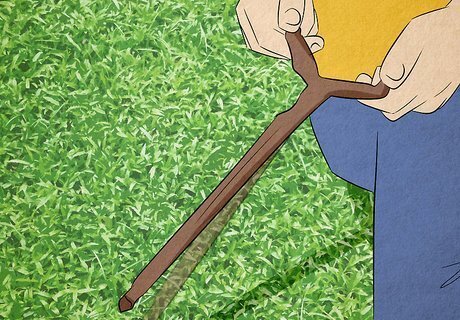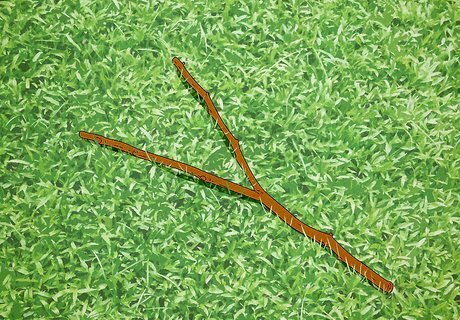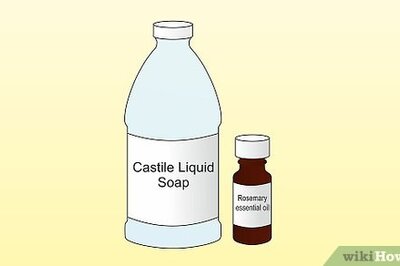
views
- Hold a Y-shaped stick by the prongs with your palms facing upward. Or, cut a coat hanger into 2 pieces and bend them in L-shapes, holding one in each hand.
- Clear your mind and think about what it is you’d like to find, then slowly start walking around the area, paying attention to how the rod moves.
- Expect a Y-rod to move downward when you’re near water or lost objects. L-rods may point you in the proper direction, then cross when you’re near.
Finding Bodies of Water or Lost Objects

Envision what you want to find in your mind. Before you begin dowsing, go to the area you want to dowse and hold the rod in your hands. Then, close your eyes and clear your mind by breathing deeply in and out for about a minute. Picture what you want to locate in your mind, whether it’s a source of water or something you lost. Silently repeat the question, “Where is it?” to focus on the task at hand. Keep in mind that, while some people still employ dowsers to find water, it’s not a scientifically proven practice. If it’s an emergency, find water by looking for signs of thick vegetation or by listening for running water from a creek or river. If you need to find water for a landscaping or development project, consider contacting your local county authority to get in touch with an official surveyor who can give you a full report on the area’s features.

Slowly walk around the area while holding the rod(s). While keeping the rod(s) level and your mind focused on what you’re trying to find, walk around the space at a slow, even pace. For large, open spaces, start by walking back and forth in straight lines, as though mowing a lawn. For smaller, more confined spaces, stop and stand still every so often to observe the rods.

Find what you’re looking for when the rod(s) dip down or cross. When dowsing with a Y-rod, it’s believed that the outstretched section of the stick jerks downward when it detects water or lost objects. Watch for these downward movements; the more dramatic, the closer you are to the object. If you move away and the rod stops moving, turn around and go back to get closer to what you’re trying to find. If you’re using L-rods, the rods may point you in the direction of your object by simultaneously moving in the same direction. Follow them as though they’re arrows pointing you where to go! When they cross at the tips, it means you’re very close to whatever you’re looking for. If you’re using a pendulum, it’s thought that the pendulum swings in the direction of the object. This might be the trickiest of the dowsing tools; stop frequently to read the motion of the pendulum.
Asking Yes or No Questions

Quiet your mind and hold the rods steady. For communicating with spirits, dowsers typically use L-shaped rods or pendulums. While holding your rods in front of you, relax and clear your mind by taking a few deep breaths. The idea is to channel your negative and positive energy through the rods. Many believe that this opens them up as a channel for communication with spirits, but to communicate, you need a quiet, open mind. For spirit dowsing, go ahead and sit down if that’s more comfortable for you. You don’t need to be especially mobile.

Ask the rods to cross to establish your spiritual connection. Before you dive into your actual questions, you need to make sure the rods are able to cooperate. It’s a bit like having someone on the other end pick up the phone. Tilt the rods so that they point away from each other. Then say, “Please cross the rods,” and hold still and wait for the rods to do so. You may need to ask repeatedly or wait several minutes for the rods to cooperate. Be patient! Some believe that when they do cross, you’re connected to another presence that can answer your questions.

Ask your question out loud. Focus the question in your mind for a minute or two, repeating it silently. Once you’re completely focused on it, say it out loud. Start with an easy question you know the answer to, to help you gauge the accuracy of the rods, which might not always have correct answers. Try something like, “Am I standing?” or, “Am I inside right now?” Alternatively, determine the energy in a room by asking something like, “Is there positive energy here?”

Get answers when the rods cross or open. When using L-shaped rods, crossed rods indicate a “No,” while wide-open rods indicate a “Yes.” Unmoving or parallel rods might mean that the presence doesn’t understand the question or doesn’t an answer. Pendulum answers vary from person to person, so first calibrate your pendulum with an obvious question that has a “Yes” answer. Take note of which direction the pendulum swings or circles; that’s the direction it will swing for “Yes,” and it’ll swing the other direction for “No,” or not move if the presence doesn’t have an answer. When using a Y-rod for yes or no questions, a downward pull indicates “Yes,” and an upward pull indicates “No.” No movement means the spirit can’t answer your question.
Making and Holding Dowsing Rods

Find a Y-shaped stick to use as a dowsing rod. Dowsing doesn’t require any special equipment; any Y-shaped stick will do. Ideally, look for a stick that has a fork with branches of about equal length on either end of the fork. Also, try to find a stick that’s 1–3 ft (0.30–0.91 m) for best results. Historically, diviners used forked sticks from trees such as willow, peach, and witch hazel. Go ahead and snap your stick down to a more comfortable size if you find one that’s a little unwieldy.

Make a dowsing rod out of a coat hanger or a necklace. If there aren’t any sticks around, improvising a dowsing rod out of household materials is easy! Cut a coat hanger (or any length of wire) so you have 2 pieces of wire that are about 1–2 ft (0.30–0.61 m) long, then bend them ⅓ of the way along the length to form 2 L-shaped dowsing rods. Or, use any sort of weighted object attached to a string or a chain, such as a necklace, or even a bit of twine tied around a rock or crystal about 1–2 in (2.5–5.1 cm) large to make a dowsing pendulum.

Hold the rod(s) an arm’s length away from your body. To hold a Y-shaped rod, grip 1 prong of the Y in either hand, with the center prong extending out from your body and angled toward the sky by about 45 degrees. Hold it with your palms facing upward and your elbows slightly bent. Hold the rod just tightly enough that it stays in place, but not so tightly that it can’t twist in your hands a bit. Or, hold 1 L-shaped dowsing rod in each fist, pointed away from your body, parallel to the ground, and just far enough apart that they can cross toward their tips when dowsing. To hold a pendulum, simply grasp the string in 1 hand and hold it an arm’s length out from your body, letting the weighted end of the pendulum dangle downward.




















Comments
0 comment